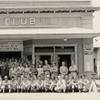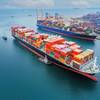Largely complementary operations, a strong base in terms of volume and technologies, plus considerable synergy potential, provided a solid platform for the coupling of the marine equipment and design activities of Norway's Ulstein group and the British-owned, specialized engineering force Vickers. At a stroke, the combined strengths represented in Vickers Ulstein Marine Systems made the new entity the leader in specific market segments. However, its wide-ranging capabilities provide the requisite resources to increase penetration in existing areas of engagement and break into new markets.
Just as the organization has quickly acted on its considerably widened package supply potential, the sustained pace of product development throughout the Vickers Ulstein network demonstrates a determination to maintain the business momentum both parties had built up as separate undertakings. The acquisition of Ulstein, bar its shipbuilding operations, was wholly in line with Vickers' strategy of business development in niche engineering sectors offering growth potential. Ulstein Holdings' robust business performance, and accelerated growth following Oslo Stock Exchange listing in the fall of 1997, has been one of Scandinavia's major industrial success stories in recent years, Vickers marine division, meanwhile, has produced solid results through the 1990s, thanks in no small way to the prudent decision 13 years ago to purchase Swedish propulsion specialist Kamewa.
While there are many elements to the new union, the coupling of the Ulstein Propeller, Bird-Johnson, Kamewa and Aquamaster bloodlines, with retained brand identities, plus associated research resources, must rank as one of the most attractive aspects of the amalgamation. The expanded in-house capability through the whole power train, including main engines, transmissions, shafting, waterjets and, now, compact gas turbines, bodes well for single-sourcing across a very substantial swath of the market. Vickers has a long and complex history, originating in Sheffield steelmaking in 1828. During both world wars, it was a major supplier of defense equipment, the most famous product being the Spitfire. Its role in airplane manufacture included its participation in the development of Concorde, which made its debut in 1969. Its withdrawal from shipbuilding came with U.K. nationalization of the industry towards the end of the 1970s. The 1986 purchase of Kamewa saw the revitalization of its marine activities, strengthened in 1995 with the takeover of Finland's Aquamaster-Rauma. Vickers' subsequent sale of Rolls-Royce Motor Cars to Volkswagen provided funds for the marine sector expansion strategy crystallizing in the marriage with Ulstein. By bringing the Norwegian-owned, international group into its fold, marine activities now constitute the largest of Vickers' three divisions, outstripping both defense systems and turbine components, the two other sectors, in terms both of turnover and employees. In technology areas such as research and development, and also in service-back-up, the strength of Vickers Ulstein is more than the sum of its parts. A number of new products have been brought to market since the May 4 formal completion of the acquisition, more are planned in the short-term, and the new division is already benefiting from joint procurement initiatives.
Bespoke fruit carriers
Italian business verve married with solid ship design skills has produced a new breed of refrigerated cargo vessel as the keypoint in a program of raising the efficiency of a Trans-Atlantic supply system linking plantations with retailers.
With her classical reefership fair lines and lean form, the 11,500-dwt Cala Pino is all the more striking for her pair of big sideport doors in the starboard shell, and two, high-stooled cranes on the weatherdeck. These are the main accoutrements of the system of rapid cargo throughput central to the bespoke design developed for the Orsero Group shipping companies Armatori Partenopei and Cosiarma.
Delivered in August, Cala Pino leads a class of four 600,000-cu. ft. capacity newbuilds scheduled to be phased into service over the remainder of 1999 from Fincantieri's Ancona shipyard. The series will boost the carrier's scope and productivity in the trade with bananas and other fruit from Latin America and the Caribbean, to southern Europe. Although the vessel type can take a weatherdeck stow of 184 reefer boxes of 40-ft, the tonnage investment program is an endorsement of pallet-optimized sea transportation methods at a time of growing penetration of the global reefer trades by the pure containership. It is also significant from a point of view of timing, with new construction activity in the conventional sector at a low ebb. Furthermore, the project is a testament to Fincantieri's broad-based design and build know-how during a period when so much attention has been focused on the group's trials and tribulations in the cruise ship domain.
The Italian hub for the Cala Pino and her 21.5-knot sisters will be Vado Ligure, near Savona, on the Italian Riviera, where the parent group controls a dedicated fresh fruit and vegetable handling facility, known as Reefer Terminal. With her three holds divided by three tweendecks, the new vessel provides for stowage of more than 4,900 pallets of perishable goods over a total refrigerated deck are of around 6,600 sq m. The home-grown side loading and discharge system, from engineering firm Goriziane, offers one of the most expeditious outturn rates throughout the industry, keyed to the owner's expectations as to fast turnarounds at Vado Ligure.
The upperdeck reefer container capacity, while offering a supplementary eastbound shipment capability, has the merit of providing an eastbound payload from Europe. The Fincantieri-developed design thereby provides the requisite stability and safety for making Atlantic transits with the holds empty but with a full weatherdeck stow. The Cala Pino-headed quartet constitutes the second fertile collaboration between Fincantieri and the Orsero Group, following the completion at Ancona of the 365,000-cu ft Cala Pevero type during 1990-92. Although significantly smaller in enclosed volume, of more modest power and speed ratings, and vested with a single sideloader rather two units, the 9,000-dwt Cala Pevero class has undoubtedly colored the Cala Pino project.
The Ancona yard, a beacon for Fincantieri's endeavors to bolster its activities in high value-added sectors of the mercantile field outside the cruiseship domain, is also breaking new ground for the group in tanker construction. Two 25,000-dwt chemtankers ordered by domestic owners will be distinguished not only by the adoption of duplex stainless steel throughout the cargo section, but also by the use of diesel-electric drive, a first for Fincantieri in newbuild tanker propulsion.
Subscribe for
Maritime Reporter E-News
Maritime Reporter E-News is the maritime industry's largest circulation and most authoritative ENews Service, delivered to your Email five times per week












